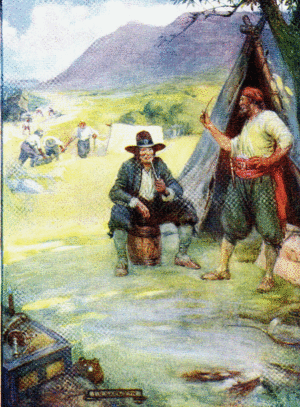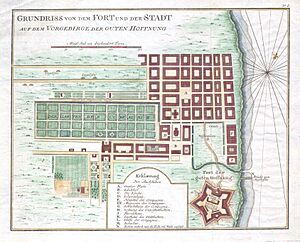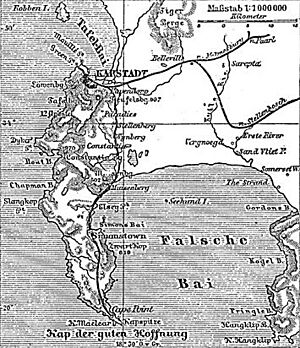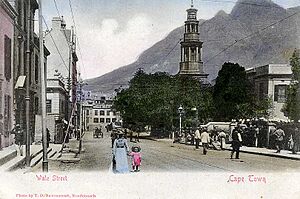History of Cape Town facts for kids
| Historical population | ||
|---|---|---|
| Year | Pop. | ±% p.a. |
| 1658 | 360 | — |
| 1731 | 3,157 | +3.02% |
| 1836 | 20,000 | +1.77% |
| 1875 | 45,000 | +2.10% |
| 1891 | 67,000 | +2.52% |
| 1901 | 171,000 | +9.82% |
| 1950 | 618,000 | +2.66% |
| 1955 | 705,000 | +2.67% |
| 1960 | 803,000 | +2.64% |
| 1965 | 945,000 | +3.31% |
| 1970 | 1,114,000 | +3.35% |
| 1975 | 1,339,000 | +3.75% |
| 1980 | 1,609,000 | +3.74% |
| 1985 | 1,933,000 | +3.74% |
| 1990 | 2,296,000 | +3.50% |
| 1996 | 2,565,018 | +1.86% |
| 2001 | 2,892,243 | +2.43% |
| 2007 | 3,497,097 | +3.22% |
| 2011 | 3,740,025 | +1.69% |
| 2016 | 4,005,016 | +1.38% |
| Note: Census figures (1996–2011) cover figures after 1994 reflect the greater Cape Town metropolitan municipality reflecting post-1994 reforms. Sources: 1658–1904, 1950–1990,
1996, 2001, and 2011 Census; 2007, 2016 Census estimates. |
||
Cape Town is a famous city in South Africa. But what was it like long ago? Before Europeans arrived, there was no written history of this area. The first time it was mentioned was in 1488 by a Portuguese explorer. The local Khoi people called the area '||Hui !Gais'. This means "where clouds gather."
Contents
Who First Explored the Cape?
The first Europeans to reach the Cape were from Portugal. In 1488, Bartholomeu Dias sailed here after exploring the west coast of Africa. Later, in 1497, Vasco da Gama also saw the Cape. He was looking for a direct sea route from Europe to Asia.
Table Mountain got its name in 1503. A Portuguese admiral named António de Saldanha called it Taboa do Cabo. This means "table of the cape." The Khoi people had their own name for it: Hoeri 'kwaggo, or "sea mountain." Later, a Portuguese group led by Francisco de Almeida fought the local Goringhaiqua Khoikhoi clan. The Portuguese lost this battle.
1652: When the Dutch Arrived
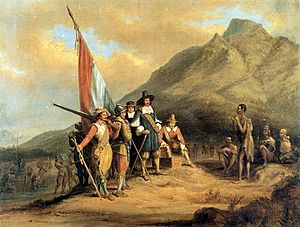
Europeans didn't visit the Cape often until 1652. That's when Jan van Riebeeck and others from the Dutch East India Company (VOC) arrived. They were sent to build a stopover point. This station would provide fresh water, food, and meat for ships traveling to and from Asia.
Van Riebeeck's three ships landed on April 6, 1652. The Dutch ruled the Cape from 1652 to 1795, and again from 1803 to 1806. The settlers quickly built shelters and planted gardens. These gardens are now known as the Company's Garden. They used water from the Fresh River for their crops. The settlers traded with the local Khoisan people for sheep and cattle. Forests in Hout Bay provided wood for building. The VOC controlled all trade at this time.
The Dutch gave names to the local people they met. They called the herders "Hottentots." People who lived by the coast and ate shellfish were called "Strandlopers." Hunter-gatherers were named "Bushmen."
The first people from Asia came to South Africa in 1654. They were sent to the Cape by the Dutch Batavian High Court. These Asian immigrants helped create the Cape Coloured and Cape Malay communities. They also brought the religion of Islam to the Cape.
In 1657, the VOC gave farms to some of its workers. This was to grow more food. These farms were along the Liesbeeck River. The VOC still controlled them. The first slaves arrived in 1658 from Java and Madagascar. They were forced to work on the farms. Around this time, the first fights began between settlers and the Khoi. The Khoi realized they were losing their land.
Work on the Castle of Good Hope started in 1666. This was the first strong European fort in the area. It replaced the wooden fort Van Riebeeck had built. The castle was finished in 1679 and is the oldest building in South Africa.
Simon van der Stel became governor in 1679. The town of Stellenbosch is named after him. Van der Stel started the Cape wine industry. He brought grapevines on his ship. This industry quickly became very important. He also encouraged the colony to expand.
In 1688, the first non-Dutch immigrants arrived. They were the Huguenots. These French Protestants had fled from persecution in France to the Netherlands. The VOC offered them free passage to the Cape and farmland. The Huguenots brought important skills in wine-making. This greatly helped the industry and added to the Cape's culture.
The 1700s: Changes and Conflicts
By 1754, the Cape settlement had 5,510 Europeans and 6,729 slaves. In 1780, France and Great Britain went to war. The Netherlands joined France's side. A small group of French soldiers came to the Cape to protect it from the British. These troops left by 1784.
By 1795, France had invaded the Netherlands. The VOC was in serious financial trouble. The Prince of Orange fled to England for safety. This led to the Dutch Batavian Republic being formed. News traveled slowly back then. The Cape Commissioner only knew that France was taking over the Netherlands. He also knew the Dutch might change sides in the war.
British forces arrived at the Cape with a letter from the Prince of Orange. The letter asked the Commissioner to let British troops protect the Cape from France. The British told the Commissioner that the Prince had fled to England. The Cape Council was divided. In the end, the British successfully invaded the Cape in the Battle of Muizenberg. The British immediately announced that trade would now be free.
Trading in slaves was a big activity during this time. A notable event was the mutiny of slaves on the ship Meermin in 1766.
The 1800s and 1900s: British Rule and Growth
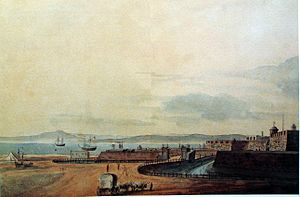
In 1802, the Cape was given back to the Dutch as part of a peace deal. But three years later, the war started again. The British returned and defeated Dutch forces at the Battle of Blaauwberg in 1806. This period brought big changes to the city. It marked the start of Cape Town as a city in its own right. Water pipes were installed along major streets. Local people were forced to live in one place. They could not move without written permission.
The war between France and England ended in 1814. The British won. They made a complex treaty where land was exchanged for money. The British permanently took the Cape from the Dutch for a large sum of money. The British saw controlling the Cape as key to their power in India. The Dutch government was too poor to argue. They agreed, but asked to still use the Cape for ship repairs and supplies.
Laws that restricted the movement of the Khoikhoi were removed in 1829. This meant the Khoikhoi were, in theory, equal to Europeans. In 1834, slaves were freed across the British Empire. About 39,000 slaves were freed in the Cape. This led to the creation of the Bo-Kaap area by a freed Muslim community. The Cape Town Legislative Council was also formed in 1834.
A very important event in South African history, the Great Trek, began in 1836. About 10,000 Dutch families left for the north. They were looking for new land. This opened up the country's interior. In 1840, the Cape Town Municipality was formed. At that time, the city had 20,016 people, with 10,560 being white.
The Cape Colony slowly moved towards more independence from Britain. In 1849, a British plan to make the Cape a prison colony caused a crisis. People did not want this. In 1854, the Cape Colony elected its first parliament. This parliament allowed people of all races to vote if they met certain rules. In 1872, the Cape gained responsible government. This meant it could elect its own leaders and Prime Minister. A time of strong economic growth followed. The Cape Government Railways expanded quickly, connecting Cape Town to the vast interior.
The discovery of diamonds and gold in the Transvaal in the 1870s and 1880s changed Cape Town rapidly. Cecil Rhodes, a powerful colonialist, gained influence. He was fueled by the new diamond industry. When he became Prime Minister, he limited the voting rights of non-white people. He also pushed for British control to expand inland. This led to more tension between different groups. It was followed by the Anglo-Boer War.
As Johannesburg grew from the gold fields, Cape Town lost its place as the only major city. But as the main port, it still benefited from increased trade. The wealth from minerals helped create an industrial society. This period also saw the first signs of segregation in the city. After an outbreak of bubonic plague, which was blamed on native Africans, they were moved. They were sent to two areas outside the city. One was near the docks, and the other was at Ndabeni, about six kilometers east of the city.
The Apartheid Years
The settlement at Ndabeni grew into the townships of the Cape Flats. In 1948, the National Party won the election. Their policy was called apartheid, which meant strict racial segregation. After many legal battles, the voting rights of the Coloured community in Cape Province were taken away.
In 1966, the lively District Six area was destroyed. It was declared a white-only area. This and other similar actions under the Group Areas Act forced whole communities to move. They were relocated to the Cape Flats.
Under apartheid, the Cape was seen as a "Coloured labor preference area." This meant Black Africans were excluded. The government tried for decades to remove largely Xhosa squatter camps, like Crossroads. These camps were centers of black resistance against apartheid. In the last forced removal, between May and June 1986, about 70,000 people were kicked out of their homes.
Recent Times
On February 11, 1990, Nelson Mandela was released from prison. Hours later, he gave his first public speech in decades from the balcony of the Cape Town City Hall. This marked the start of a new era for South Africa.
In August 1998, a bomb exploded at the city's Planet Hollywood restaurant. One person died, and many were injured.
Cape Town's Water Crisis
From 2015 to 2018, Cape Town faced a severe drought. The city was close to running out of water. But a combination of rainfall and water saving by residents prevented this from happening. The crisis officially ended in early 2020.
See also
- Timeline of Cape Town history
- Greenmarket Square
- Autshumato
- Krotoa
- Trams in Cape Town
- Trolleybuses in Cape Town
Images for kids
-
Rock paintings from the Western Cape


